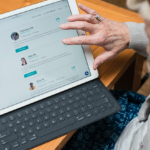Home Modification Ideas for The Elderly
As our loved ones get older you may find them complaining about new discomfort that have limited their activity. You may even have noticed the increased difficulty they are facing yourself. There are many home modifications for the elderly that can help making a home more comfortable and safe. We take a look at some key activities that can help.We’re here to help.
Call us if you have any questions about our exceptional live-in care.
020 3870 4220
This is not just limited to outdoor activities but also inside one’s own home. Just one flight of stairs can be a challenge for someone with osteoarthritis.
Home adaptations are designed to make it safer and easier for your loved ones to stick to their normal daily routine. These can include many changes from technical to physical ones. The smallest change can make the biggest difference for the elderly.
Handrails for the elderly
Handrails or grab rails are one of the most common home instalments for the elderly. The elderly often suffer from debilitating joint conditions like rheumatoid arthritis or osteoarthritis that make it difficult or painful for them to move around. Additionally, some conditions that cause dizziness also make it necessary for such a support system to be installed. Besides the obvious benefits of preventing falls in the dark, handrails may also assist in moving around the house, standing up from sitting down, and getting in and out of bed. Another option for people with stairs in their home may be a stairlift, this is great for stroke survivors or people with any type of paralysis.
Bathroom adaptations for the elderly
The bathroom can be one of the most vulnerable places for the elderly. The presence of water and soap makes it likely for a fall to happen. This situation is further exacerbated if the door is locked. It is better to prevent such an incident from occurring instead of reaping the consequences later. The usual installations for the elderly include support rails in the shower or bath as well as around the toilet seat itself. This not only decreases the likelihood of falls but also provides the needed support elderly people usually need to stand up from a prolonged sitting position. These rails are sturdy and well fitted so they can support the whole bodyweight of the individual.
Another option is to get a battery-operated bath lift that to ease the individual in and out of the bath. This is a good option for someone who has difficulty getting up. A additionally, if the installation of a new bathtub is within your range you may consider a tub with a side opening. Other additional safety measures and easy adaptations include long-handled sponges, bath mats, and grips.
Technological home adaptations
A common problem the elderly run into is having to get up to answer the door, even to know just who it is. This is why an intercom system would be a great fix. This system will not only allow your loved one to converse with the visitor from the comfort of their chair but also open the door with the click of a button. All of this without having to get up. This may seem trivial but it provides great ease in the life of an elderly person.
Another way to tackle this problem is by attaching a police-approved safe outside the home which has the key to the individual’s home. The combination of the safe will only be known to close family and friends. This method also prevents frequent trips to the door and helps with home improvements for the elderly.
Home adaptations for moving around safely
The elderly often suffer from poor eyesight, this can be further exacerbated by darkness. This is why you should make sure their home is well lit and all the light switches are well within reach. This can be done by installing a switch panel near the bed, near the toilet, outside the door, etc. Or you can even install motion sensor lights which turn on automatically as soon as the person walks not the room.
Another modification to make moving around safer is to widen door frames or change the placement of the hinges on the door. This is usually specifically helpful for people who move around in wheelchairs.
Home adaptations in the kitchen
The kitchen is also another dangerous part of the home. But many adaptations can be made to make it a safe environment. For example, providing a stool to reach the top shelf, a kettle tipper to tip the kettle safely, a spike board, this allows you to cut vegetables with one hand, wide handled cutlery, labelled drawers and cabinets, and a trolley or basket to help move groceries from the car to the kitchen or pantry.
Telecare adaptations
- Wearable alarms — such as necklace to call for help in the event of an accident
- Emergency alarms — such as fire and smoke detectors in case of accidental fires
- Movement sensors — such as detecting if you’re out of bed, can be integrated with lighting and heating systems.
- Incontinence sensors — devices that can alert the carer for assistance
Telecare includes a range of different sensors, switches detectors, and devices that are all integrated to provide additional support and reassurance for family members and the person themselves. This is a suitable option for suffers from diseases like dementia. Some examples of telecare systems include:
How to arrange home adaptations for the elderly
If you find that you are unsure whether your loved one needs any or all of this support you can contact the social services council for a home assessment. This assessment is done by an experienced professional who evaluates the condition of your loved one by conducting an interview. It is a good idea to accompany your loved one during this interview in case they miss out on some details. This interview is usually followed by a home inspection and then the inspector will advise you on the updates that need to be made to the house. The inspector will also provide information on whom to contact for these instalments and any further queries you might have. You will find that some home modifications for elderly are installed free of cost from your council. You can find out more about the home assessment providers in your area on the NHS website.
Do you need extra support moving safely around your own home?
Hometouch provides live-in care packages that provide around-the-clock, professional care. Our live-in carers can help the elderly in maintaining safety, support mobility, and prevent falls.





